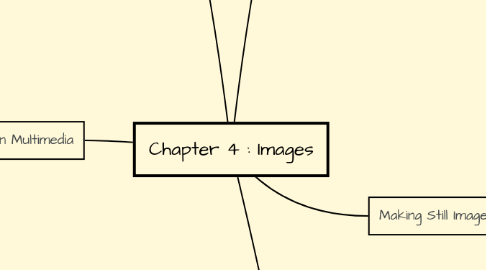
1. 3-D drawing and rendering
1.1. 3-D animation tools
1.1.1. Daz3D
1.1.2. NewTek′s Lightwave
1.1.3. Autodesk’s Maya
1.2. Features of a 3-D application
1.2.1. Modeling
1.2.1.1. Placing all the elements into 3-D space.
1.2.2. Extrusion
1.2.2.1. The shape of a plane surface extends some distance
1.2.3. Lathing
1.2.3.1. A profile of the shape is rotated around a defined axis
1.3. Panoramas
1.4. Rendering
1.4.1. Use of intricate algorithms to apply user-specified effects
2. Colors and Palettes in Multimedia
2.1. Understanding natural light and color
2.1.1. Light comes from an atom where an electron passes from a higher to a lower energy level.
2.1.2. Each atom produces uniquely specific colors
2.1.3. Color is the frequency of a light wave within the narrow band of the electromagnetic spectrum to which the human eye responds
2.1.4. Additive color
2.1.4.1. In the additive color method, a color is created by combining colored light sources in three primary colors - red, green, and blue (RGB)
2.1.4.2. TV and computer monitors use this method
2.1.5. Subtractive color
2.1.5.1. Subtractive color is the process used to create color in printing
2.1.5.2. The printed page consists of tiny halftone dots of three primary colors: cyan, magenta, and yellow (CMY).
2.1.5.3. The printed page consists of tiny halftone dots of three primary colors: cyan, magenta, and yellow (CMY).
2.1.6. Color Models
2.1.6.1. RGB model – A 24-bit methodology: color is specified in terms of red, green, and blue values ranging from 0 to 255
2.1.6.2. HSB and HSL models – Color is specified as an angle from 0 to 360 degrees on a color wheel
2.2. Color palettes
3. Image File Types Used in Multimedia
3.1. Macintosh formats
3.1.1. On the Macintosh, the most commonly used format is PICT
3.1.2. PICT is a complicated and versatile format developed by Apple
3.1.3. Almost every image application on the Macintosh can import or export PICT files
3.2. Windows formats
3.2.1. The most commonly used image file format on Windows is DIB, also known as BMP.
3.2.1.1. DIB stands for device-independent bitmaps
3.2.2. Bitmap formats used most often by Windows developers are
3.2.2.1. BMP - A Windows bitmap file
3.2.2.2. TIFF - Extensively used in DTP packages
3.2.2.3. PCX - Used by MS-DOS paint software
3.3. Cross-platform formats
3.3.1. JPEG, GIF, and PNG – Most commonly used format on the Web
3.3.2. Adobe Portable Document Format (PDF) – Manages multimedia content
3.3.3. PSD, AI, CDR, DXF – Proprietary formats used by applications
3.3.4. COLLADA 3D – Standard for transferring 3-D files
4. Before You Start to Create
4.1. Plan your approach
4.1.1. Outline project and graphics ideas first – Make a flowcharts and storyboards
4.2. Organize the available tools
4.2.1. Most authoring systems provide the tools with which can create the graphic objects of multimedia directly on screen
4.3. Configure computer workspace
4.3.1. Have multiple monitors, if possible, for lots of screen real estate (viewing area)
5. Making Still Images
5.1. Still images may be the most important element of a multimedia project
5.2. Still images may be small or large, or even full screen. They may be colored, placed at random on the screen, evenly geometric, or oddly shaped.
5.3. Still images are generated in two ways
5.3.1. Bitmaps
5.3.1.1. Bitmap is derived from the words “bit,” which means the simplest element in digital world, an electronic digit that is either on or off, black or white, or true (1) or false (0).
5.3.1.2. A bitmap is a simple matrix of the tiny dots that form an image and are displayed on a screen or printed
5.3.1.3. Bitmaps are an image format suited for creation of
5.3.1.3.1. Photo-realistic images
5.3.1.3.2. Complex drawings requiring fine detail
5.3.2. Vector-drawn graphics
5.3.3. Vector-drawn graphics
5.3.3.1. Applications of vector-drawn object
5.3.3.1.1. Graphic artists designing for the print media
5.3.3.1.2. 3-D animation programs – changes of position, rotation, and shading of light
5.3.3.1.3. Applications requiring drawing of graphic shapes
5.3.3.1.4. Computer-aided design (CAD) programs needed by architects and engineer
5.3.3.2. How vector-drawn images work
5.3.3.2.1. A vector is a line that is described by the location of its two endpoints
5.3.3.2.2. Vector drawing makes use of Cartesian coordinates.
5.3.3.2.3. Cartesian coordinates are numbers that describe a point in two- or three-dimensional space as the intersection of the X, Y, and Z axes.
5.3.3.3. Vector-drawn images versus bitmaps
5.3.3.3.1. Vector images use less memory space and have a smaller file size as compared to bitmaps
5.3.3.3.2. Vector objects are easily scalable without loss of resolution or image quality
5.3.3.3.3. For the Web, pages that use vector graphics in plug-ins download faster and, when used for animation, draw faster than bitmaps
5.3.3.3.4. Vector images require a plug-in for web-based display.
5.3.3.3.5. Bitmaps are not easily scalable and resizable.
5.3.3.3.6. Bitmaps can be converted to vector images using autotracing.

